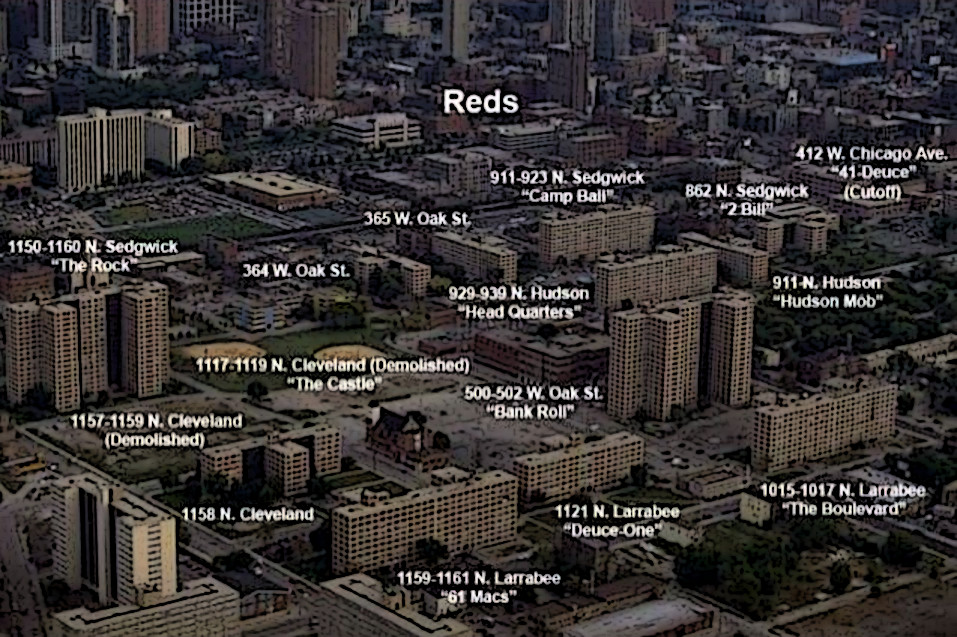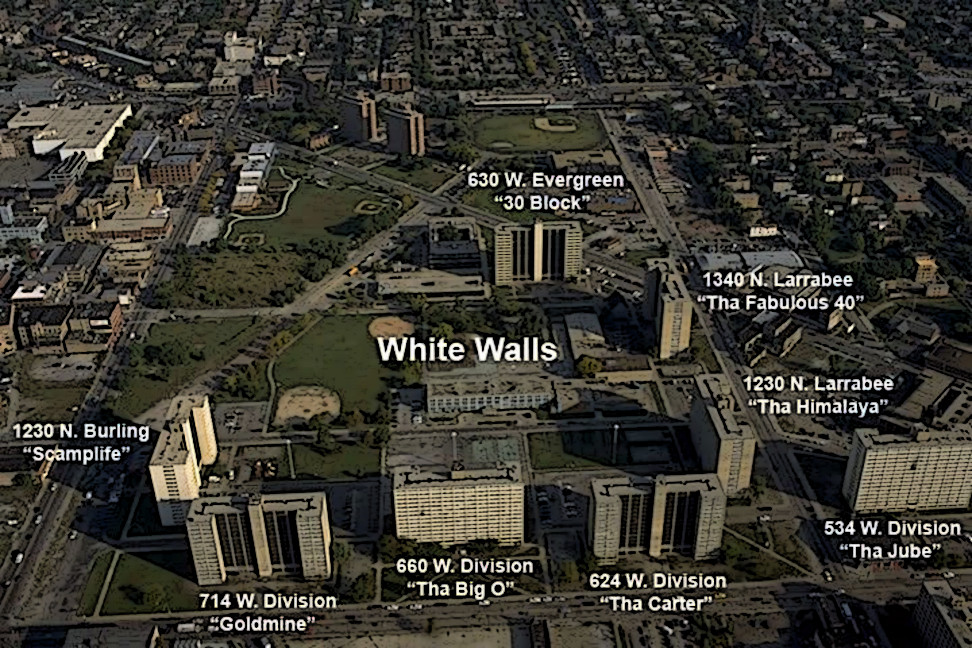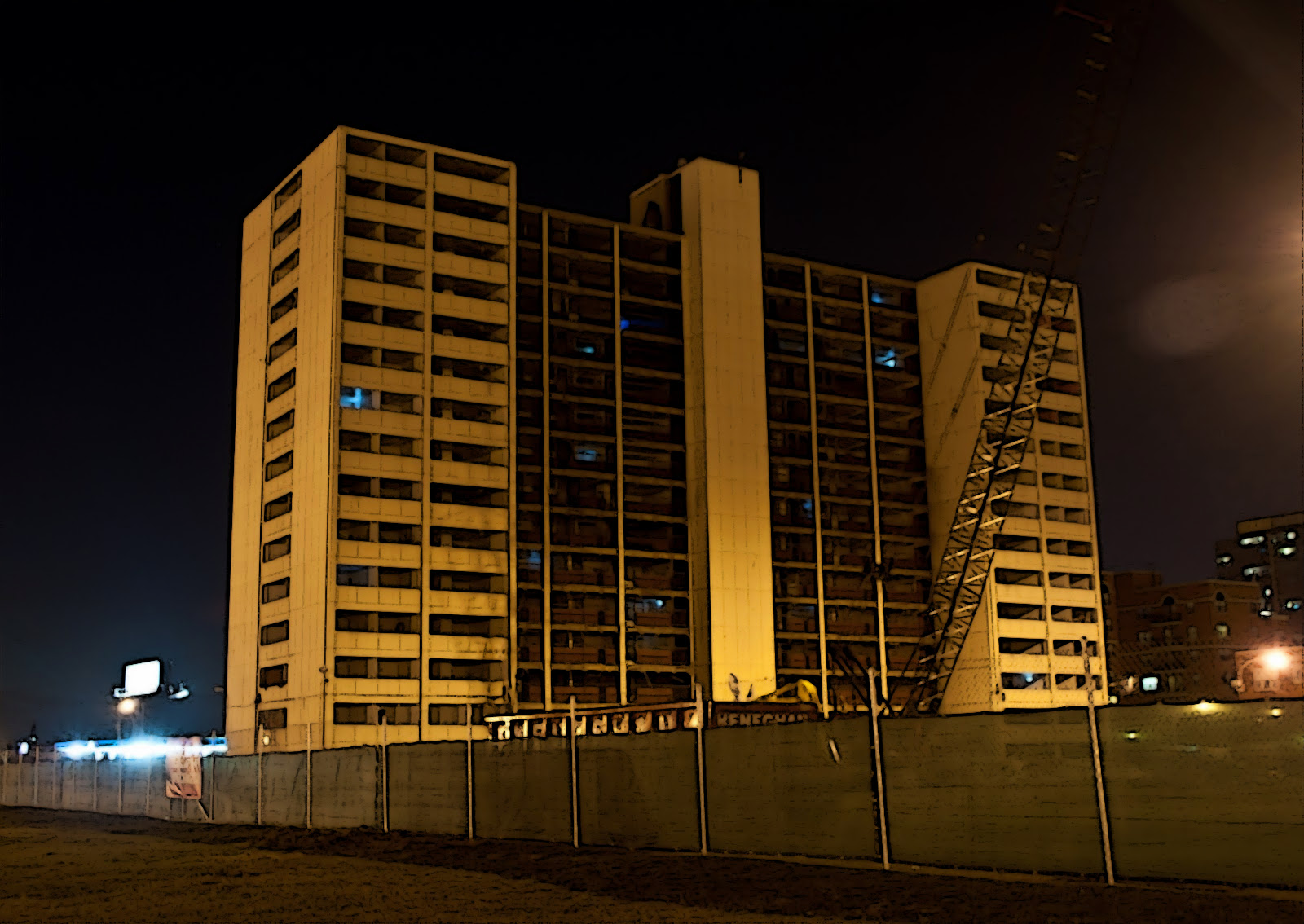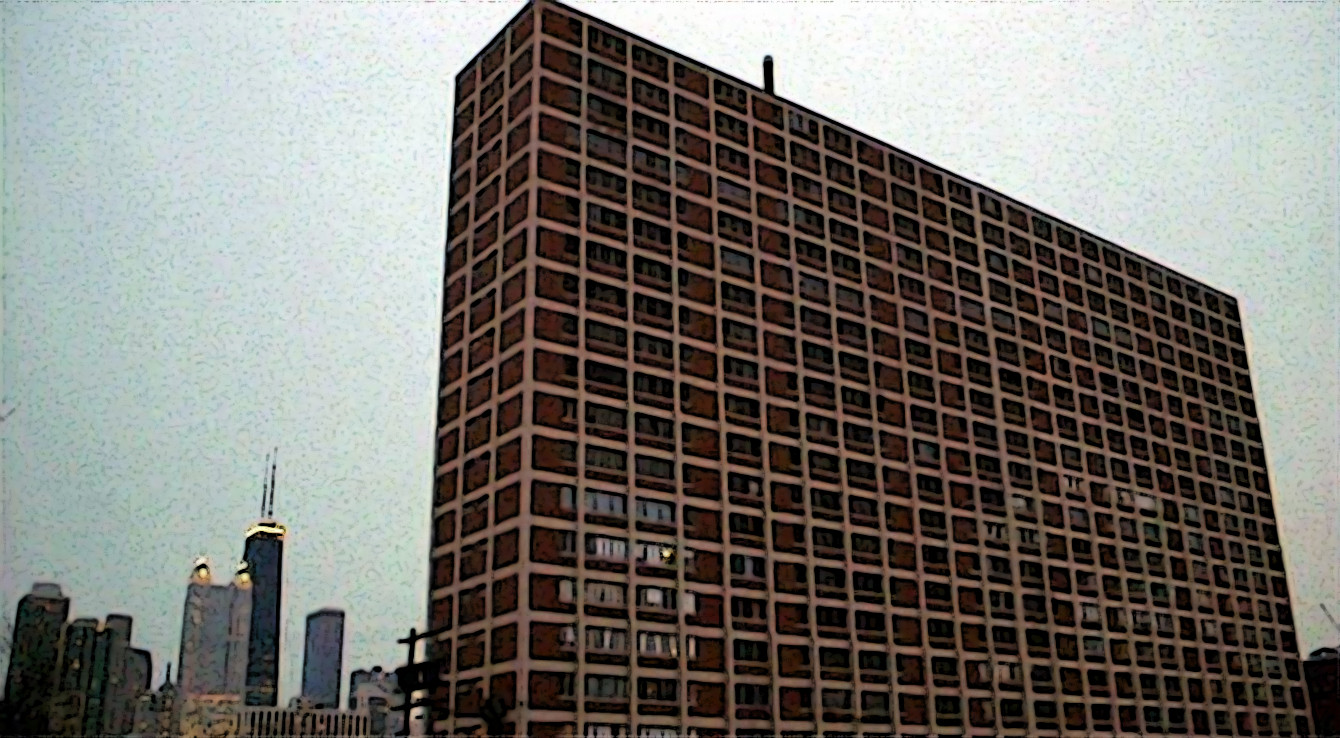Difference between revisions of "Frances Cabrini Row-houses and William Green Homes"
(→Development) |
(→Timeline) |
||
| Line 25: | Line 25: | ||
=== Timeline === | === Timeline === | ||
| + | *'''1850:''' Shanties were first built on low-lying land along Chicago River; the population was predominantly Swedish, then Irish. The area acquires the "Little Hell" nickname due to a nearby gas refinery, which produced shooting pillars of flame and various noxious fumes. By the 20th century, it was known as "Little Sicily" due to large numbers of Sicilian immigrants. | ||
| + | *'''1929:''' Harvey Zorbaugh writes "The Gold Coast and the Slum: A Sociological Study of Chicago's Near North Side", contrasting the widely varying social mores of the wealthy Gold Coast, the poor Little Sicily, and the transitional area in between. Marshall Field Garden Apartments, first large-scale (although funded through private charity) low-income housing development in area, completed. | ||
| + | *'''1942:''' Frances Cabrini Homes (two-story rowhouses), with 586 units in 54 buildings, completed. Initial regulations stipulate 75% white and 25% black residents. Holsman, Burmeister, et al., architects. (Named for Saint Frances Cabrini, an Italian-American nun who served the poor and was the first American to be canonized.) | ||
| + | *'''1957:''' Cabrini Homes Extension (red brick mid- and high-rises), with 1,925 units in 15 buildings, is completed. A. Epstein & Sons, architects. | ||
| + | *'''1962:''' Green Homes (1,096 units, north of Division Street) is completed. Pace Associates, architects. (Named for William Green, longtime president of the American Federation of Labor.) | ||
| + | *'''1966:''' Gautreaux et al. vs. Chicago Housing Authority, a lawsuit alleging that Chicago's public housing program was conceived and executed in a racially discriminatory manner that perpetuated racial segregation within neighborhoods, is filed. CHA was found liable in 1969, and a consent decree with HUD was entered in 1981. | ||
| + | *'''April 4–13, 1968:''' In the days immediately following the assassination of Dr. Martin Luther King, Jr., constant gunfire from snipers positioned on the upper floors of Cabrini–Green caused many casualties and much property damage. The sniper activity would return periodically throughout the 1970s. | ||
| + | *'''July 17, 1970:''' Sergeant James Severin and Officer Tony Rizzato of the Chicago Police Department are fatally shot. | ||
| + | *'''February 8, 1974:''' Television sitcom Good Times, ostensibly set in the Cabrini–Green projects (though the projects were never actually referred to as "Cabrini-Green" on camera), and featuring shots of the complex in the opening and closing credits, debuts on CBS. It would run for six seasons, until August 1, 1979. | ||
| + | *'''March 26 – April 19, 1981:''' Mayor Jane Byrne moves into Cabrini–Green to prove a point regarding Chicago's high crime rate. Considered a publicity stunt, she stays just three weeks. | ||
| + | *'''October 13, 1992:''' Dantrell Davis was holding his mother's hand on his way to school, when he was fatally shot by a stray bullet. | ||
| + | *'''1992:''' Candyman is released, the story taking place at the housing project. | ||
| + | *'''1994:''' Chicago receives one of the first HOPE VI (Housing Opportunities for People Everywhere) grants to redevelop Cabrini–Green as a mixed-income neighborhood. | ||
| + | *'''September 27, 1995:''' Demolition begins. | ||
| + | *'''January 9, 1997:''' Nine-year-old "Girl X" (since identified as Shatoya Currie) found in a seventh-floor stairwell at 1121 N. Larrabee Street after being raped, beaten, choked, poisoned by having a can of insecticide sprayed down her throat, and covered in gang symbols. Her attacker then stepped on her throat. She was left for dead. Ultimately, the attacker was identified as Patrick Sykes and was found with the assistance of community members and building gang members, all of whom were outraged by the attack. Sykes had a history of sexual crimes against women and girls, and admitted he covered Currie with gang symbols in an attempt to confuse investigators. Currie survived, but was blinded and left with significant brain damage. During her hospitalization, Nation of Islam leader Louis Farrakhan visited and prayed at her bedside. | ||
| + | *'''1997:''' Chicago unveils Near North Redevelopment Initiative, a master plan for development in the area. It recommends demolishing Green Homes and most of Cabrini Extension. | ||
| + | *'''1999:''' Chicago Housing Authority announces Plan for Transformation, which will spend $1.5 billion over ten years to demolish 18,000 apartments and build and/or rehabilitate 25,000 apartments. Earlier redevelopment plans for Cabrini–Green are included in the Plan for Transformation. New library, rehabilitated Seward Park, and new shopping center open. | ||
| + | *'''December 9, 2010:''' The William Green Homes complex's last standing building closes. | ||
| + | *'''March 30, 2011:''' the last high-rise building was demolished, with a public art presentation commemorating the event. The majority of abandoned and rundown Frances Cabrini Homes row houses remain intact and a hot bed for crime in the area. | ||
Revision as of 20:16, 8 October 2016
During the Day
Development
The construction reflected the "urban renewal" approach to United States city planning in the mid-20th century.

The extension buildings were known as the "red" for their red brick exteriors, while the Green Homes, with reinforced concrete exteriors, were known as the "whites".

Many of the high-rise buildings originally had exterior porches (called "open galleries"). According to the Chicago Housing Authority (CHA), the early residents of the Cabrini row houses were predominantly of Italian ancestry. By 1962, however, a majority of residents in the completed complex were black.

Timeline
- 1850: Shanties were first built on low-lying land along Chicago River; the population was predominantly Swedish, then Irish. The area acquires the "Little Hell" nickname due to a nearby gas refinery, which produced shooting pillars of flame and various noxious fumes. By the 20th century, it was known as "Little Sicily" due to large numbers of Sicilian immigrants.
- 1929: Harvey Zorbaugh writes "The Gold Coast and the Slum: A Sociological Study of Chicago's Near North Side", contrasting the widely varying social mores of the wealthy Gold Coast, the poor Little Sicily, and the transitional area in between. Marshall Field Garden Apartments, first large-scale (although funded through private charity) low-income housing development in area, completed.
- 1942: Frances Cabrini Homes (two-story rowhouses), with 586 units in 54 buildings, completed. Initial regulations stipulate 75% white and 25% black residents. Holsman, Burmeister, et al., architects. (Named for Saint Frances Cabrini, an Italian-American nun who served the poor and was the first American to be canonized.)
- 1957: Cabrini Homes Extension (red brick mid- and high-rises), with 1,925 units in 15 buildings, is completed. A. Epstein & Sons, architects.
- 1962: Green Homes (1,096 units, north of Division Street) is completed. Pace Associates, architects. (Named for William Green, longtime president of the American Federation of Labor.)
- 1966: Gautreaux et al. vs. Chicago Housing Authority, a lawsuit alleging that Chicago's public housing program was conceived and executed in a racially discriminatory manner that perpetuated racial segregation within neighborhoods, is filed. CHA was found liable in 1969, and a consent decree with HUD was entered in 1981.
- April 4–13, 1968: In the days immediately following the assassination of Dr. Martin Luther King, Jr., constant gunfire from snipers positioned on the upper floors of Cabrini–Green caused many casualties and much property damage. The sniper activity would return periodically throughout the 1970s.
- July 17, 1970: Sergeant James Severin and Officer Tony Rizzato of the Chicago Police Department are fatally shot.
- February 8, 1974: Television sitcom Good Times, ostensibly set in the Cabrini–Green projects (though the projects were never actually referred to as "Cabrini-Green" on camera), and featuring shots of the complex in the opening and closing credits, debuts on CBS. It would run for six seasons, until August 1, 1979.
- March 26 – April 19, 1981: Mayor Jane Byrne moves into Cabrini–Green to prove a point regarding Chicago's high crime rate. Considered a publicity stunt, she stays just three weeks.
- October 13, 1992: Dantrell Davis was holding his mother's hand on his way to school, when he was fatally shot by a stray bullet.
- 1992: Candyman is released, the story taking place at the housing project.
- 1994: Chicago receives one of the first HOPE VI (Housing Opportunities for People Everywhere) grants to redevelop Cabrini–Green as a mixed-income neighborhood.
- September 27, 1995: Demolition begins.
- January 9, 1997: Nine-year-old "Girl X" (since identified as Shatoya Currie) found in a seventh-floor stairwell at 1121 N. Larrabee Street after being raped, beaten, choked, poisoned by having a can of insecticide sprayed down her throat, and covered in gang symbols. Her attacker then stepped on her throat. She was left for dead. Ultimately, the attacker was identified as Patrick Sykes and was found with the assistance of community members and building gang members, all of whom were outraged by the attack. Sykes had a history of sexual crimes against women and girls, and admitted he covered Currie with gang symbols in an attempt to confuse investigators. Currie survived, but was blinded and left with significant brain damage. During her hospitalization, Nation of Islam leader Louis Farrakhan visited and prayed at her bedside.
- 1997: Chicago unveils Near North Redevelopment Initiative, a master plan for development in the area. It recommends demolishing Green Homes and most of Cabrini Extension.
- 1999: Chicago Housing Authority announces Plan for Transformation, which will spend $1.5 billion over ten years to demolish 18,000 apartments and build and/or rehabilitate 25,000 apartments. Earlier redevelopment plans for Cabrini–Green are included in the Plan for Transformation. New library, rehabilitated Seward Park, and new shopping center open.
- December 9, 2010: The William Green Homes complex's last standing building closes.
- March 30, 2011: the last high-rise building was demolished, with a public art presentation commemorating the event. The majority of abandoned and rundown Frances Cabrini Homes row houses remain intact and a hot bed for crime in the area.
